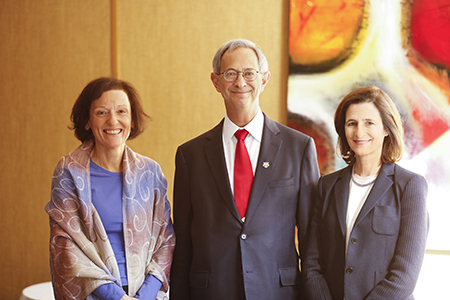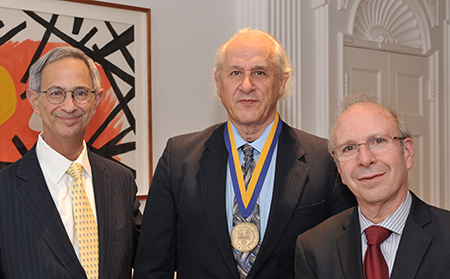A Meliora Message

Meliora Weekend is six weeks away. Soon campus will be flooded with visitors, many of whom may not have been here in a while, leading to exclamations like “I can’t believe how much it has changed!”
There have been a lot of physical changes—some more visible than others. Morey Hall’s main entry lobby is looking more like its 1930s self. More public art has been added to the River Campus, above and below ground. The stunning, new Golisano Children’s Hospital is now a cheerful beacon at the Medical Center, standing triumphantly without construction fencing. And these are only some of the most recent transformations.
We’ve been busy.
In her remarks at the groundbreaking for a new medical office building on the University’s South Campus, Nina Schor, M.D., the pediatrician-in-chief and William H. Eilinger Chair of Pediatrics at Golisano Children’s Hospital, shared that she was asked if she gets tired of attending groundbreakings. Given our steady stream of capital projects, it was a fair question. Dr. Schor’s answer provided an inspiring adjustment of perspective: “This is really not about groundbreakings in the literal sense. This is about changing lives.”
In other words, it's about people. It's about those who will benefit from the building’s services; those who will utilize the building’s space to teach, provide care, or conduct research; and those who help make these buildings possible.
You are among them.
Thank you for allowing us to be tireless in our efforts to enhance our University and its ability to serve our community and humanity.
[Go to Top]
New Site for Imaging, Autism Care

Joel Seligman breaks ground for new medical building on the University's South Campus with UR Medicine, state, and Rochester-area leaders, as well as local families
Anyone traveling near the University’s South Campus will have a hard time missing the heavy machinery excavating the grounds alongside East River Road. And if they’re guessing the University is growing again, they’re right.
On August 17, a groundbreaking ceremony was held for a three-story, 90,000-square-foot building that will house the UR Medicine Imaging Center and the William and Mildred Levine Autism Clinic. President and CEO Joel Seligman led the celebration marking the start of another key project that will enhance the University’s patient-centric facilities and extend its regional health care leadership.
“This expansion will transform the way we deliver care and provide leading-edge technology and therapies to people who travel near and far for UR Medicine expertise,” said Seligman.
Occupying the new building’s first two floors, the Imaging Center will create easier, and more comfortable, access to diagnostic services for about 250,000 people each year. In addition to convenience, it allows for a dedicated interventional radiology clinic to expand the use of minimally invasive, image-guided procedures to diagnose and treat diseases.
The third floor will house the region’s first coordinated care clinic for children and youth with autism spectrum disorder. Made possible by a $1 million gift from the William and Mildred Levine Foundation, the Levine Autism Clinic will enable patients and familes to see developmental and behavioral, psychological, and neurological care providers in one place. Children in need of these important services—in the past year, more than 500 children were diagnosed with autism spectrum disorder at the Medical Center—will have a child-friendly space that caters to their special physical, sensory, and environmental needs.
“We are a regional destination for complex pediatric care and imaging sciences,” said Mark Taubman, M.D., CEO of UR Medicine and the Medical Center and dean of the School of Medicine and Dentistry. “As we create a health care network throughout upstate New York, more patients will come to rely on us for services and technologies that are available only through our Medical Center. This facility is the latest example of our commitment to making services more accessible.”
Patients and their families will have the opportunity to benefit from the state-of-the-art technology and integrated services when the building opens in early 2017.
You can read more about this exciting new project in the official press release.
[Go to Top]
Grateful Patient Morris Supports Cardiac Care

Joel Seligman, Marjorie B. Morris, Peter A. Knight, M.D., and Mark Taubman, M.D.
Weakness and difficulty breathing landed Clifton Springs resident Marjorie B. Morris a visit with heart surgeon Peter A. Knight ’87 (Flw), P’11, P’19, and not a day too soon. The symptoms that were keeping Morris from tending her garden were actually warnings for a life-threatening condition: a faulty heart valve. Knight ultimately replaced the valve, enabling Morris to return to her active lifestyle. For Morris, “thank you, doctor” was not enough.
Inspired by Knight’s expertise and compassion, Morris made a $1.5 million commitment to establish the Marjorie B. Morris Endowed Professorship in Cardiac Surgery to fully demonstrate her gratitude and support for the advancement of cardiac care.
“The care I received was excellent and I was able to go home within a week,” said Morris. “The personal contact with Dr. Knight and his reassurance throughout the process was wonderful.”
Morris is far from alone in her high regard for Knight. On July 24, members of the University community gathered to recognize Knight as an outstanding surgeon, researcher, and mentor during a ceremony formally installing him as the inaugural Morris Professor.
“We are deeply grateful for Mrs. Morris’ generosity as we establish this professorship to further patient care, research, and education,” said Mark B. Taubman, M.D., CEO of the Medical Center and UR Medicine and dean of the School of Medicine and Dentistry. “First-rate surgeons like Peter Knight are part of what attracted me to practice medicine in Rochester. Peter, in particular, makes our community a great place to receive care.”
Morris and her late husband, Isaac (Drew), devoted much of their time to community service and the restoration and preservation of Main Street, Clifton Springs. Over time, she developed a reputation for vision and generosity that stimulated change and progress. She is now doing that at the Medical Center. Through the Morris Professorship, Morris is helping to advance Knight’s clinical research to expand innovative surgical device development and providing support for additional cardiac research, education, and improved clinical care for generations.
UR Medicine’s cardiac surgeons are at the forefront of the use of cardiac-assist devices and advanced surgical treatments, such as heart transplants and the implantation of pacemakers and implantable cardioverter defibrillators. Knight is expanding URMC’s research into less-invasive technology and procedures to improve outcomes for patients.
You can read more about Morris’ gift in the official press release.
[Go to Top]
Strawderman and Bohmann Installed as Foster Professors

Joel Seligman; Dirk Bohmann, Ph.D.; Donald Foster's brother, David Foster, J.D.; Robert Strawderman, Sc.D.; and Mark Taubman, M.D.
Research is about answering questions. For example, Dirk Bohmann, Ph.D., wants to know how to slow or prevent age-related diseases, like cancer, before their onset. In relation to this, Robert Strawderman, Sc.D., who focuses his work on survival analysis, is exploring new statistical methods to help us better understand how a patient’s age, type of cancer, genomic profile, and treatment plan influence the risk of death and other related events.
Both scientists are now better equipped to pursue the answers they seek thanks to the generosity of the late Donald M. Foster ’50M (MD).
On August 13, Strawderman, chair of the Department of Biostatistics and Computational Biology, was formally installed as the Donald M. Foster, M.D. Distinguished Professor in Biostatistics, and Bohmann, co-director of the Rochester Aging Research Center (RoAR), was formally installed as the Donald M. Foster, M.D. Professor in Biomedical Genetics.
“Dr. Robert Strawderman and Dr. Dirk Bohmann are proven leaders in their fields and in our classrooms,” said President and CEO Joel Seligman. “I am thrilled to be able to recognize their excellence with these professorships, which we could not have established without the remarkable generosity of Donald Foster. Through Robert, Dirk, and their successors, Donald’s legacy will be forever tied to Medicine of the Highest Order.”
Foster was a longtime contributor to the School of Medicine and Dentistry annual fund and a charter (and lifetime) member of the George Hoyt Whipple Society. To ensure his support was everlasting, he included a generous provision to the University in his estate plans. After his death in 2013, his loyalty and giving were recognized with the creation of the Foster Professorships. His estate gift also helped fully fund the Martha M. Freeman, M.D. Professorship in Biomedical Genetics.
Donors like Foster have helped the School of Medicine and Dentistry establish 52 professorships since the beginning of The Meliora Challenge. And as the School’s dean Mark B. Taubman, M.D., CEO of the Medical Center and UR Medicine and dean of the School of Medicine and Dentistry, would say, they are critical for retaining our top faculty who educate and inspire our students, and work on important scientific discoveries.
“Dirk and Robert are exemplary scientists, teachers, and mentors, who are making tremendous contributions to solving major health and health care issues that could impact people around the world,” said Taubman. “They deserve this great honor, and I look forward to seeing the ways in which they continue to lead us to new levels in care, research, and the training of our fellows and students.”
Strawderman has more than 20 years of experience working with interdisciplinary teams of scientists on projects focused on clinical research, health care delivery and evaluation, and various areas of public health. His research includes statistical methods for risk and outcome prediction in medicine and those for evaluating the cost and quality of health care.
Director of the Genetics, Genomics and Development Graduate Program, Bohmann focuses his research on the molecular biology of gene and cell regulation as it applies to topics such as aging or the movement of cancerous cells in living tissue. He is the author of nearly 100 papers and received the Wilmot Cancer Institute's Davey Memorial Award for Outstanding Cancer Research in 2010.
[Go to Top]
Maxion Family Receives Highland’s Highest Honor

Linda Maxion’s family with Highland Hospital Chaplain Don Marlar (far back) and Bilal Ahmed, M.D., associate chief of medicine at Highland (far right), who were instrumental in Linda’s care and the creation of the garden.
When Highland Hospital patients need a break from their clinical environment, they don’t have to go far for respite. Since October 2014, they have been able to enjoy the natural spaces and colorful plantings of Linda’s Garden. The outdoor garden offers a serene, open area that provides healthy doses of fresh air and a setting for therapeutic activity, relaxation with friends and family, or meditation. More than anything else, it is a place that promotes healing.
The “healing garden” is the realized vision of its namesake Linda Maxion, who often had extended stays at Highland while battling cancer. Linda lost her battle in April 2013, but not before making a $200,000 gift through the Maxion Family Charitable Fund of the Rochester Area Foundation. Her leadership, support, and love for her community helped bring her idea to life and forever enhanced the patient experience at Highland.
On August 19, the Highland Hospital Foundation recognized that legacy by presenting Linda's family with its highest honor: the Heritage Award.
Linda Maxion’s vision was transformative and inspirational in the creation of the Healing Garden,” said Mark Eidlin, chairman of the Highland Hospital Foundation’s Board of Directors. “As a patient, volunteer, and champion of Highland, I’m so glad the hospital has Linda’s Garden and that the Foundation is able to recognize Linda’s family with the Heritage Award in her honor.”
The Heritage Award is given to a person or organization whose time, talent, and philanthropic contributions play a significant role at Highland Hospital and within the community. Past recipients include University Trustee Thomas Richards and his wife Betty; Eileen Grossman, co-founder of The Cancer Wellness Spa of Greater Rochester; and Eva Pressman, the Henry A. Thiede Professor of Obstetrics and Gynecology and her husband, Seth Zeidman, M.D.
[Go to Top]





















